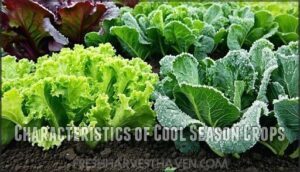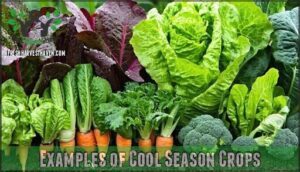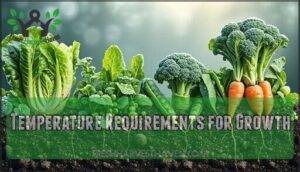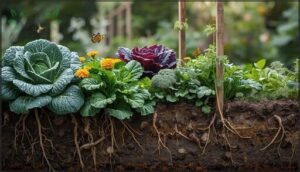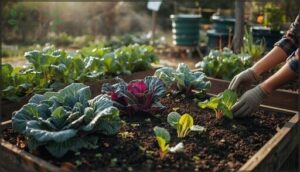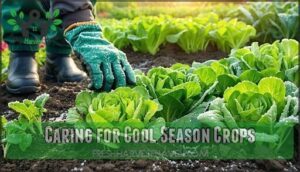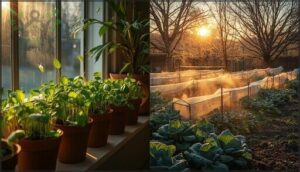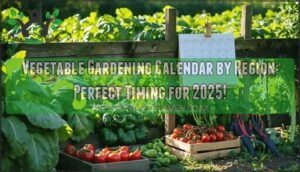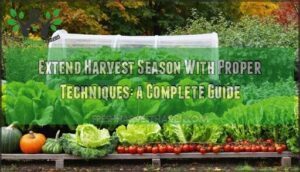This site is supported by our readers. We may earn a commission, at no cost to you, if you purchase through links.
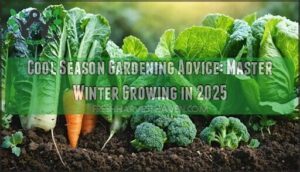
You’ll want to plant leafy greens like kale and spinach, root vegetables such as carrots and beets, plus brassicas including broccoli and cabbage about 10-12 weeks before your first frost date.
These hardy plants need consistent moisture and well-draining soil enriched with compost.
Use companion planting to maximize space—pair broccoli with marigolds for pest control, or grow peas with carrots for nitrogen fixation.
Row covers and cold frames extend your harvest well into winter, transforming what most consider the gardening off-season into your most productive months.
Table Of Contents
- Key Takeaways
- Cool Season Crops
- Companion Planting Benefits
- Gardening Practices
- Caring for Cool Season Crops
- Indoor and Outdoor Growing Tips
- Frequently Asked Questions (FAQs)
- Can you grow vegetables in a cool season?
- When should you plant cool-season crops?
- How do I start fall gardening?
- How do you care for a cold weather vegetable plant?
- Can you save fall crops for early spring?
- What is cool season planting?
- How do you start a cool season vegetable garden?
- How can I extend my growing season?
- Can you plant vegetables in a cool-season garden?
- Why is seasonal gardening important?
- Conclusion
Key Takeaways
- Plant 10-12 weeks before your first frost date – You’ll need to count backward from your area’s first expected frost using seed packet maturity times, then add 1-2 weeks for slower fall growth to ensure proper harvest timing.
- Use companion planting to maximize garden efficiency – You can pair broccoli with marigolds for natural pest control, grow peas with carrots for nitrogen fixation, and plant aromatic herbs like rosemary near brassicas to repel cabbage moths.
- Extend your growing season with protection methods – You’ll achieve continuous harvests by using row covers for 4-8°F temperature boosts, cold frames for greenhouse-like conditions, and succession planting every 10-14 days.
- Choose bolt-resistant varieties for reliable harvests – You should select heat-tolerant cultivars like ‘Jericho’ lettuce or ‘Winterbor’ kale that won’t rush to seed during temperature fluctuations, ensuring consistent production through winter months.
Cool Season Crops
Cool season crops thrive in temperatures between 35-75°F, making them perfect for fall and winter gardening when warm-season plants struggle.
These hardy vegetables actually improve in flavor after frost exposure, giving you fresh harvests well into the cold months.
Frost transforms cool-season vegetables into candy-sweet garden gems that laugh at winter’s bite
Characteristics of Cool Season Crops
Understanding cool season crops starts with recognizing their unique cold-weather adaptations.
These hardy vegetables thrive when temperatures hover between 40-75°F, utilizing specialized C3 photosynthesis that’s perfectly suited for cooler, moist conditions.
Cool season crops possess remarkable characteristics that distinguish them from warm-weather varieties:
- Frost Hardiness enables survival down to 28°F, with hardy types withstanding even harder freezes
- Germination Speed accelerates in cool soil temperatures as low as 35°F
- Crop Maturity Rates remain steady despite shorter days and reduced sunlight
- Cool Weather Tolerance allows continuous growth while warm-season plants go dormant
Their shallow root systems require consistent moisture, while their enhanced leaf thickness maximizes cold-light absorption.
Many species actually enter semi-dormancy below 40°F, resuming vigorous growth when soil temperature rises.
This natural adaptation makes them perfect for extending your growing season well beyond summer’s end.
Examples of Cool Season Crops
Cool-season champions work in nature’s favor when summer heat retreats.
Leafy greens like Hardy Lettuce and spinach thrive in morning frost.
Root Vegetables including radishes and carrots develop sweetness underground.
Fall Brassicas such as kale and broccoli actually improve after cold snaps.
Asian Greens like bok choy and mizuna add variety, while Cool Flowers including pansies provide color through winter’s chill.
Temperature Requirements for Growth
Mastering soil temperature transforms your cool-season success. These hardy vegetables germinate when soil reaches 35-45°F, while optimal growth temperatures hover between 50-65°F. Frost tolerance varies dramatically—spinach survives 20°F, kale withstands 10°F. Germination rates peak when you hit those cool season thresholds.
Picture your thriving winter garden:
Feel the frost kiss your morning harvest as winter vegetables sweeten beneath gray December skies
- Lettuce seedlings emerging from 40°F soil like green confetti
- Carrots sweetening after that first crisp frost kiss
- Peas climbing trellises in chilly morning air
- Broccoli heads forming under gray winter skies
- Radishes swelling in cold, dark earth
Monitor soil temperature daily at 6-inch depth for precise timing. Understanding cold weather protection is essential for a successful winter harvest.
Companion Planting Benefits
You’ll discover that strategic companion planting transforms your cool-season garden into a thriving ecosystem where plants naturally support each other’s growth and health.
The right plant partnerships can boost yields, repel pests, and maximize your garden space during the cooler months.
Broccoli Companion Combinations
Broccoli thrives when partnered with strategic companions that create natural pest deterrents and boost garden productivity.
Your broccoli patch becomes a fortress when you plant aromatic herbs like rosemary, sage, and dill nearby—these powerhouses repel cabbage moths and aphids while attracting beneficial insects.
Nutrient synergy kicks in when you pair broccoli with onions and shallots, reducing pest damage by 15% while optimizing soil resources.
Growth support comes from unexpected allies:
- Marigolds act as living shields, drawing pests away from your precious broccoli heads
- Celery creates a moisture-conserving microclimate that speeds head formation
- Chamomile whispers sweet secrets to broccoli, improving flavor and boosting yields by 10%
This space optimization strategy maximizes your garden’s potential through flavor enhancement partnerships that work smarter, not harder.
By utilizing broccoli companion plants, gardeners can create a balanced ecosystem that promotes healthy growth and reduces pest pressure.
Pea Companion Combinations
Pea pairings transform your garden into a nitrogen-rich powerhouse where every plant thrives together.
These legume friends fix atmospheric nitrogen, creating fertile conditions that benefit surrounding crops.
You’ll discover that pea neighbors like carrots develop sweeter flavors when planted nearby—the loose soil structure peas create helps carrot roots penetrate deeper without resistance.
Turnips make stellar garden allies, improving soil drainage while their strong scent deters aphids and flea beetles that commonly attack pea plants.
Lettuce grows exceptionally well as companion crops with peas, since it appreciates the enriched nitrogen levels and partial shade the climbing vines provide.
Cucumbers can share vertical support systems with peas, maximizing space efficiency in smaller gardens.
Radishes planted between pea rows break up compacted soil naturally while their fast growth doesn’t compete for resources.
This nitrogen-sharing partnership creates a self-sustaining ecosystem where plants actively support each other’s growth and pest resistance throughout the cool season.
By utilizing effective companion planting strategies, gardeners can enhance the overall health and productivity of their gardens.
Onion Companion Combinations
Beyond traditional companion planting, onions serve as your garden’s multi-tool for cool season success.
These aromatic allies excel at Onion Pairings that maximize Crop Diversity while strengthening your Interplanting Strategies. Smart Garlic Companions create natural pest barriers, while their sulfur compounds enhance Soil Amendments for healthier crops.
Here are five proven onion companion combinations:
- Beets: Onions repel leaf miners while beets utilize different root zones
- Carrots: Natural pest deterrent against carrot flies and root maggots
- Cabbage: Protects against cabbage worms and flea beetles effectively
- Lettuce: Provides wind protection while deterring aphids naturally
- Spinach: Compatible growth rates with complementary nutrient uptake patterns
Kale Companion Combinations
Kale’s robust nature makes it a perfect anchor plant for your cool-season garden, and choosing the right companions can dramatically boost your harvest success. Kale Pairings work best when you understand which plants enhance growth versus those that compete for nutrients.
Companion Flowers like marigolds and nasturtiums aren’t just pretty—they actively repel aphids and cabbage worms that love munching on kale leaves. Meanwhile, Vegetable Synergy happens when you plant lettuce and spinach nearby, creating natural ground cover that retains soil moisture.
Garden Diversity thrives when you add aromatic herbs like rosemary and thyme, which mask kale’s scent from pests. Crop Harmony reaches its peak with this strategic pairing system:
| Beneficial Companions | Pest-Fighting Partners |
|---|---|
| Lettuce, Spinach | Marigolds, Nasturtiums |
| Radishes, Carrots | Rosemary, Thyme |
| Bush Peas | Mint, Chives |
This companion approach transforms your winter garden into a self-supporting ecosystem where each plant contributes to the others’ success.
Gardening Practices
Successful cool season gardening starts with proper timing—plant 10-12 weeks before your first expected frost date using your ZIP code’s specific planting calendar.
You’ll need to prepare your soil with compost, plan strategic crop rotations, and master succession planting techniques to maximize your harvest window throughout the colder months, using techniques like succession planting.
Planting Preparation and Timing
Timing separates thriving cool season gardens from disappointing ones. Your Frost Date Calculation marks when planting windows open and close—count backward from this date using seed packet maturity times, then add two weeks for slower fall growth.
Soil Temperature monitoring beats calendar watching every time. Seeds won’t germinate in frozen ground, regardless of air warmth. Seed Selection for your climate zone prevents costly replanting mistakes.
- Start transplants indoors 6-8 weeks before last spring frost
- Direct sow fall crops 10-12 weeks before first expected frost
- Check soil reaches 40°F minimum for most cool season varieties
- Plan Planting Schedules with succession sowings every 10-14 days
- Time Harvest Timing by adding "fall factor" weeks to packet dates
Using soil temperature monitoring tools removes guesswork from your garden planning equation.
Garden Planning and Crop Rotation
Strategic crop rotation transforms your garden from pest paradise into productive powerhouse.
Smart bed planning prevents soilborne diseases while maximizing yields through systematic plant family movements across growing zones.
Your rotation arsenal includes:
- Garden maps tracking four-year crop family cycles across designated beds
- Soil preparation schedules matching nutrient needs to previous plantings
- Fall planting calendars rotating brassicas, legumes, and root vegetables annually
- Bed planning systems dividing space into 3-4 rotational zones
- Documentation tracking pest patterns and soil amendments by location
This methodical approach cuts disease pressure by 60% while boosting long-term soil health and harvest reliability.
Effective raised beds management is essential for maintaining healthy and productive gardens.
Planting Cool Season Crops
Successful crop selection begins with matching varieties to your climate zone and planting window. Cool season champions like spinach and lettuce thrive when you time plantings correctly.
Direct sowing works perfectly for hardy crops—scatter radish seeds directly into prepared beds when soil becomes workable. For vegetables requiring longer development, seed starting indoors gives broccoli and cauliflower the head start they need before transplanting outdoors.
Your fall planting strategy depends on choosing bolt-resistant varieties that won’t rush to seed when temperatures fluctuate. Cold-hardy kale varieties extend your harvest well into winter months.
Garden layout maximizes space by succession planting lettuce every two weeks. Plant deeper-rooted crops like carrots alongside shallow-rooted greens for efficient space usage.
Understanding cool season seeds is vital for a successful harvest.
| Method | Best Cool Season Crops |
|---|---|
| Direct Sowing | Spinach, lettuce, radishes |
| Seed Starting | Broccoli, cauliflower, cabbage |
| Transplanting | Started seedlings of brassicas |
Proper soil preparation guarantees strong germination rates and healthy plant development throughout the cooler growing season.
Preparing The Garden for Cool Season Crops
Once you’ve selected your crops, proper garden bed cleanup sets the stage for fall success. Clear debris, spent plants, and weeds that harbor pests and diseases.
Follow your fall planting calendar for ideal soil preparation timing:
- Test soil pH: Aim for 6.0-7.0 to maximize nutrient uptake for cool-season varieties
- Add organic matter: Work in 2-3 inches of compost to improve soil structure and drainage
- Plan garden layout optimization: Position tall crops north to prevent shading shorter plants
- Install supports early: Set up trellises for peas and protective barriers before planting
- Apply crop selection tips: Group plants by water and spacing needs for easier maintenance
Understanding cool season gardening is essential for a successful harvest. Smart preparation now means healthier plants and bigger harvests later.
Caring for Cool Season Crops
Once you’ve planted your cool-season vegetables, proper care determines whether you’ll harvest crisp lettuce in December or watch your crops struggle through winter’s challenges.
Your success hinges on managing soil temperatures, extending growing seasons with protection, and selecting varieties that won’t bolt when temperatures fluctuate, which involves complete concepts like these to ensure a successful harvest.
Soil and Air Temperature Requirements
Your soil temperature holds the key to successful cool season growing—aim for that sweet spot between 40-65°F where seeds actually want to germinate. A simple soil thermometer becomes your best friend here, especially since germination rates plummet when temperatures drop below 35°F or climb above 70°F.
Air circulation matters more than you’d think. Good airflow prevents fungal issues without creating harsh wind tunnels that stress your plants. Those temperature fluctuations between day and night? They’re actually beneficial for cool crops, but avoid spots where temps swing wildly.
Soil insulation through organic matter helps buffer your plants against sudden temperature swings. Add compost or aged manure to create that protective layer your roots crave.
Most cool weather vegetables boast impressive frost tolerance—spinach laughs at 20°F while kale actually sweetens after frost exposure. Black plastic mulch warms soil faster, letting you plant earlier than impatient neighbors who ignore soil temps.
Extending The Growing Season
Once you’ve optimized soil temperatures, Season Extension methods can push your harvest window months beyond traditional limits.
These techniques transform your garden from a seasonal hobby into a year-round food production system.
Cold Frames capture solar heat while blocking wind, creating protected microclimates that can extend growing seasons by up to four weeks.
Frost Protection through row covers adds 5-10°F of warmth, safeguarding tender shoots during unexpected temperature drops.
Winter Harvesting becomes reality when you combine these protection methods with cold-hardy varieties.
Your season extension toolkit includes:
- Floating row covers that create instant frost barriers while allowing light penetration
- Poly tunnels providing greenhouse-like conditions at fraction of the cost
- Succession planting every 10-14 days ensuring continuous harvests through winter
Crop Covering strategies like these can yield fresh greens well into December.
Overwintering spinach alone produces up to 30 pounds per 100 square feet when properly protected, proving that winter doesn’t mean gardening hibernation.
Protecting Cool Season Plants From Frost
Your harvest window expands with smart Frost Protection Methods, but unexpected cold snaps can wipe out weeks of growth overnight. Don’t let Jack Frost steal your winter vegetables—arm yourself with proven Freeze Damage Prevention tactics.
Row Cover Techniques using lightweight fabric create protective microclimates around plants, raising temperatures by 4-8°F while allowing sunlight through. Cold Frame Gardening with old windows transforms exposed beds into mini-greenhouses. Winter Mulching with straw insulates roots and moderates soil temperature swings.
Essential frost protection strategies:
- Water plants thoroughly before frost—moist soil retains heat longer than dry ground
- Install floating row covers when temperatures drop below 35°F
- Position water-filled jugs near plants to release stored heat overnight
- Harvest tender crops before hard freezes hit your area
- Gradually harden seedlings outdoors for 7-10 days before transplanting
Choosing Bolt-Resistant Varieties
Smart Seed Selection transforms your cool-season garden from unpredictable to reliable. Bolt Resistance becomes your secret weapon when March temperatures unexpectedly spike to 70°F.
Lettuce
Variety Comparison reveals that heat-tolerant cultivars outlast standard types by 2-3 weeks. Crop Hardiness varies dramatically between cultivars—’Winterbor’ kale survives 10°F while regular varieties fail at 25°F.
Understanding cool season gardening principles is essential for making informed decisions. Your Gardening Strategies should prioritize these resilient varieties for consistent harvests despite weather surprises.
Indoor and Outdoor Growing Tips
You’ll master both indoor and outdoor cool season growing by understanding how different environments affect plant development and cold tolerance.
Whether you’re nurturing microgreens on a windowsill or protecting kale through winter frosts, the right techniques guarantee continuous harvests when warm-season crops have long since disappeared.
Growing Vegetables Indoors
Your windowsill can become a powerhouse for year-round vegetable production when you master the fundamentals of indoor growing. Cool-season crops like lettuce, spinach, and herbs thrive under controlled conditions, giving you fresh harvests regardless of weather outside.
Here’s your indoor growing blueprint:
- Indoor Lighting: Position LED grow lights 6-12 inches above plants for 14-16 hours daily to replicate ideal sunlight conditions
- Container Selection: Use containers with drainage holes—4-inch pots for seedlings, 6-8 inch for mature plants like kale and lettuce
- Hydroponics Systems: Consider simple water-based setups for faster growth rates and cleaner harvests of leafy greens
- Vertical Gardening: Maximize space with tiered shelving systems that accommodate multiple crops in compact areas
Pest Control becomes manageable indoors through proper ventilation and regular plant inspection. To optimize growth, consider supplemental LED lighting. You’ll catch problems before they spread.
Gardening Tips for Cool Weather
Mastering cool weather gardening means adapting your approach to nature’s slower rhythm. Frost protection through floating row covers and cold frames keeps crops thriving when temperatures drop.
Your watering strategies shift too—check soil moisture weekly since winter plants drink less but still need consistent hydration. Mulching techniques with dark materials absorb precious sunlight, warming root zones naturally.
For soil health, add compost before planting to buffer temperature swings. Pest control becomes simpler as cold reduces insect activity.
| Technique | Temperature Benefit | Success Rate |
|---|---|---|
| Row Covers | +5-10°F protection | 90% effective |
| Dark Mulch | +3-4°F soil warming | 85% helpful |
| Cold Frames | +10-15°F interior | 95% reliable |
| Compost Addition | +2-3°F insulation | 80% beneficial |
| Proper Drainage | Prevents root rot | 75% improvement |
Time your plantings 10-12 weeks before first frost for ideal results.
Cold Hardiness of Vegetables
Why does knowing your vegetables’ Frost Tolerance matter? Because it determines which crops survive your Hardiness Zones and thrive during winter months.
Winter Survival depends on selecting the right vegetables for your climate. Cold exposure actually triggers Flavor Enhancement in many crops through natural sugar accumulation.
Overwintering Techniques start with understanding these categories:
- Hardy vegetables survive 20°F and below (kale, Brussels sprouts)
- Semi-hardy crops tolerate 25-32°F (beets, carrots)
- Mature plants withstand cold better than seedlings
- Purple varieties show superior cold resistance
Transitioning From Cool to Warm Seasons
Transitioning garden beds requires strategic timing and smart planning for Warm-Season Prep success.
You’ll avoid plant stress by managing this seasonal shift thoughtfully.
Here’s your transition roadmap:
- Monitor soil temperatures reaching 60°F before introducing Summer Crop Starts like tomatoes and peppers
- Practice succession planting by interplanting warm-season seedlings among mature cool crops for continuous productivity
- Select Heat-Tolerant Varieties and plan Timing around your last frost date for maximum results
This approach prevents Avoiding Bolting while maximizing garden space efficiency.
Frequently Asked Questions (FAQs)
Can you grow vegetables in a cool season?
Yes, you can absolutely grow vegetables in cool seasons. Cool-weather crops like lettuce, spinach, kale, and radishes actually thrive in temperatures below 60°F and often taste better after frost exposure.
When should you plant cool-season crops?
Plant cool-season crops 10-12 weeks before your first expected frost date. Count backward from that date using seed packet maturity days, then add 1-2 weeks for slower fall growth.
How do I start fall gardening?
Calculate your first frost date, then count backward using seed packet maturity days plus two weeks for slower fall growth. Start with quick crops like lettuce and radishes.
How do you care for a cold weather vegetable plant?
Cold weather vegetables might seem fragile as delicate snowflakes, but they’re surprisingly resilient warriors.
Water consistently, use row covers for protection, mulch around plants, and harvest regularly to encourage continued growth throughout the season, which makes them resilient.
Can you save fall crops for early spring?
You can extend fall crops into early spring using season extension techniques. Cold frames, row covers, and mulch protect overwintering spinach, kale, and other hardy greens from harsh weather conditions.
What is cool season planting?
Strike while the iron’s hot with cool season planting—you’re growing vegetables that thrive in temperatures below 60°F.
These hardy crops like lettuce, spinach, and kale actually prefer cooler weather and can withstand frost better than warm-season plants.
How do you start a cool season vegetable garden?
Start by determining your first frost date using your ZIP code, then count backward based on seed packet maturity days plus two weeks for slower fall growth.
How can I extend my growing season?
Use row covers, cold frames, and succession planting to protect crops from frost. Mulch beds, water early mornings, and plant cold-hardy varieties like kale and spinach for continuous harvests.
Can you plant vegetables in a cool-season garden?
Looking to maximize your harvest beyond summer’s end?
You can absolutely plant vegetables in a cool-season garden.
Focus on frost-tolerant crops like kale, spinach, lettuce, and radishes that actually thrive in temperatures below 60°F and sweeten after frost exposure.
Why is seasonal gardening important?
Seasonal gardening maximizes your harvest by aligning planting schedules with natural growing conditions.
You’ll reduce pest pressure, conserve water, and grow healthier crops that thrive in their preferred temperatures and daylight hours, which ultimately leads to a more successful and healthier harvest.
Conclusion
Despite common beliefs that winter ends productive gardening, you’ll discover cool season gardening advice proves otherwise.
These cold-hardy crops actually prefer temperatures between 35-75°F and develop enhanced sweetness after frost exposure.
You’ve now learned essential techniques—from strategic companion planting to season extension methods using row covers and cold frames.
Your understanding of proper timing, soil preparation, and variety selection sets the foundation for year-round harvests.
Winter gardening isn’t just possible; it’s your opportunity for the most rewarding growing season yet.
- https://growhappierplants.com/companion-plants-for-broccoli/
- https://www.epicgardening.com/broccoli-companion-plants/
- https://gardenerspath.com/plants/vegetables/broccoli-companion-plants/
- https://attra.ncat.org/publication/companion-planting-resources/
- https://www.rasnetwork.org/companion-planting/broccoli-companion-plants-with-chart/

